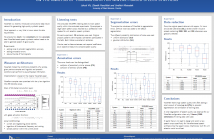
- Read more about Cyborg Speech: Deep Multilingual Speech Synthesis for Generating Segmental Foreign Accent with Natural Prosody
- Log in to post comments
We describe a new application of deep-learning-based speech synthesis, namely multilingual speech synthesis for generating controllable foreign accent. Specifically, we train a DBLSTM-based acoustic model on non-accented multilingual speech recordings from a speaker native in several languages. By copying durations and pitch contours from a pre-recorded utterance of the desired prompt, natural prosody is achieved. We call this paradigm "cyborg speech" as it combines human and machine speech parameters.
- Categories:
 39 Views
39 Views
- Read more about An investigation of subband WaveNet vocoder covering entire audible frequency range with limited acoustic features
- Log in to post comments
Although a WaveNet vocoder can synthesize more natural-sounding speech waveforms than conventional vocoders with sampling frequencies of 16 and 24 kHz, it is difficult to directly extend the sampling frequency to 48 kHz to cover the entire human audible frequency range for higher-quality synthesis because the model size becomes too large to train with a consumer GPU. For a WaveNet vocoder with a sampling frequency of 48 kHz with a consumer GPU, this paper introduces a subband WaveNet architecture to a speaker-dependent WaveNet vocoder and proposes a subband WaveNet vocoder.
- Categories:
 221 Views
221 Views
- Read more about NATURAL TTS SYNTHESIS BY CONDITIONING WAVENET ON MEL SPECTROGRAM PREDICTIONS
- Log in to post comments
- Categories:
 78 Views
78 Views
- Read more about TEXT-TO-SPEECH SYNTHESIS USING STFT SPECTRA BASED ON LOW-/MULTI-RESOLUTION GENERATIVE ADVERSARIAL NETWORKS
- Log in to post comments
- Categories:
 29 Views
29 Views
- Read more about NON-PARALLEL VOICE CONVERSION USING VARIATIONAL AUTOENCODERS CONDITIONED BY PHONETIC POSTERIORGRAMS AND D-VECTORS
- Log in to post comments
- Categories:
 26 Views
26 Views
- Read more about On the use of WaveNet as a Statistical Vocoder
- Log in to post comments
- Categories:
 18 Views
18 Views
- Read more about An Investigation of Noise Shaping with Perceptual Weighting for WaveNet-based Speech Generation
- Log in to post comments
We propose a noise shaping method to improve the sound quality of speech signals generated by WaveNet, which is a convolutional neural network (CNN) that predicts a waveform sample sequence as a discrete symbol sequence. Speech signals generated by WaveNet often suffer from noise signals caused by the quantization error generated by representing waveform samples as discrete symbols and the prediction error of the CNN.
ICASSP2018_NS.pdf
- Categories:
 299 Views
299 Views
- Read more about On the analysis of training data for wavenet-based speech synthesis
- Log in to post comments
In this paper, we analyze how much, how consistent and how accurate data WaveNet-based speech synthesis method needs to be abletogeneratespeechofgoodquality. Wedothisbyaddingartificial noise to the description of our training data and observing how well WaveNet trains and produces speech. More specifically, we add noise to both phonetic segmentation and annotation accuracy, and we also reduce the size of training data by using a fewer number of sentences during training of a WaveNet model.
poster.pdf
- Categories:
 39 Views
39 Views
- Read more about MODELING-BY-GENERATION-STRUCTURED NOISE COMPENSATION ALGORITHM FOR GLOTTAL VOCODING SPEECH SYNTHESIS SYSTEM
- Log in to post comments
This paper proposes a novel noise compensation algorithm for a glottal excitation model in a deep learning (DL)-based speech synthesis system.
To generate high-quality speech synthesis outputs, the balance between harmonic and noise components of the glottal excitation signal should be well-represented by the DL network.
However, it is hard to accurately model the noise component because the DL training process inevitably results in statistically smoothed outputs; thus, it is essential to introduce an additional noise compensation process.
- Categories:
 25 Views
25 Views
- Read more about CONVOLUTIONAL SEQUENCE TO SEQUENCE MODEL WITH NON-SEQUENTIAL GREEDY DECODING FOR GRAPHEME TO PHONEME CONVERSION
- Log in to post comments
The greedy decoding method used in the conventional sequence-to-sequence models is prone to producing a model with a compounding
of errors, mainly because it makes inferences in a fixed order, regardless of whether or not the model’s previous guesses are correct.
We propose a non-sequential greedy decoding method that generalizes the greedy decoding schemes proposed in the past. The proposed
method determines not only which token to consider, but also which position in the output sequence to infer at each inference step.
- Categories:
 379 Views
379 Views